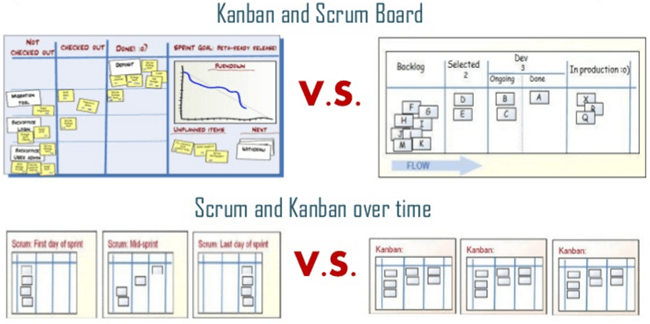Kanban and Scrum are two terminologies mostly used alternatively for each other. But fact is that there are some very vital difference between scrum and kanban Agile development methodologies. Scrum is a tool widely used to shape work into smaller, manageable parts that can be accomplished by a professional team within an assigned time period. To design, organize, assess, and improve this procedure, Scrum depends on minimum three assigned roles:
- The Product Owner is determines preliminary scheduling, prioritizing, and communication with the rest of the company.
- The Scrum Master determines supervision of the process during each sprint.
- Team Members determines to carry out the purpose of each sprint, such as producing software code.
A common tool widely used by scrum teams is the Scrum Board which is a visual representation of the work flow, broken down into manageable chunks called stories, with each story moved along the board from the backlog which is to-do list, into work-in-progress, and on to completion.
Difference Between Scrum and Kanban
| Scrum | Kanban | |
| Duties | Each member of team has a predefined role, where the Scrum master commands timelines, Product owner determines goals and objectives and team members execute the task. | There are no pre-defined roles for a team. While there may still be a Project Manager, the team is invigorated to work together and chip in when any one person becomes overwhelmed. |
| Delivery Timelines | Deliverables are determined by sprints, or set periods of time in which a set of work must be accomplished and ready for review. | Products and processes are delivered constantly on need basis and timelines are determined by business |
| Prioritization and Delegation | Also make use of a pull system nevertheless an entire batch is pulled for each iteration. | Make use of a pull system, or a systematic workflow that permits team members to only pull new tasks once the previous task is complete. |
| Perceptibility of process | Input and output only. Work is black-box | Input, work, output |
| Adjustments / Alterations | Changes during the sprint are severely discouraged. | Permits for changes to be made to a project mid-stream, permitting for iterations and incessant improvement prior to the completion of a project. |
| Calculation of Productivity | Calculates production using velocity through sprints. Each sprint is laid out concurrently so that each additional sprint depends on the success of the one before it. | Calculates production using cycle time, or the total time it takes to complete one full piece of a project from start to end. |
| Value stream | At team level for one product. | Contains product management across products. |
| Best Applications | Best for teams with stable priorities that may not alter as much over time. | Best for projects with widely fluctuating priorities. |
| Change administration | Must alter to Scrum model even if troublesome | Controllable |
| Advantages | Better transparency and project visibility Better team accountability More convenient to accommodate changes Increased cost savings |
Enhance flexibility Decreases waste More convenient understand Develops delivery flow Reduces cycle time |
| Disadvantages | More risk of scope creep Team needs experience and commitment The wrong Scrum Master can spoil everything Poorly defined tasks can result in inaccuracies |
Out-of-date board can lead to issues Teams can over complicate the board Lack of timing |






